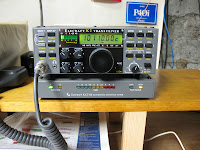I wrapped up the KAT100 project the other day and put it on-line. Here are a before and after picture.

| So, here is the "before" picture, with the Heathkit antenna tuner still on-line. |

| And here is the "after" picture. The Heathkit tuner has migrated upstairs to my office where, together with my smallwonderlabs.com PSK-20 and a zip cord dipole up in the attic, I'm back on PSK31 (see picture here). |
The only glitch in getting the KAT100 on-line was that it was DOA when I first powered it up and connected it to the K2. The Troubleshooting section of the manual directed my attention to Z1 and R5, both in the neighborhood of the CPU, where I found that I had not soldered pin 1! It was the remaining round solder pad after soldering 39 rectangular pads. Anyway, a 2 second soldering job fixed the problem, and the tuner works flawlessly, happily tuning my 40/30 meter random-length end-fed antenna. I really like the memory feature; band changes are now instantaneous.
This was a very enjoyable project! Thanks once again to Elecraft and to W3FPR.

















